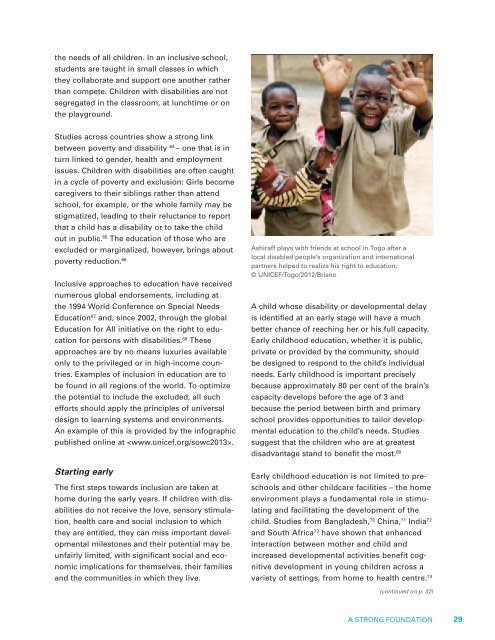Children with Disabilities
Children with Disabilities
Children with Disabilities
You also want an ePaper? Increase the reach of your titles
YUMPU automatically turns print PDFs into web optimized ePapers that Google loves.
the needs of all children. In an inclusive school,<br />
students are taught in small classes in which<br />
they collaborate and support one another rather<br />
than compete. <strong>Children</strong> <strong>with</strong> disabilities are not<br />
segregated in the classroom, at lunchtime or on<br />
the playground.<br />
Studies across countries show a strong link<br />
between poverty and disability 64 – one that is in<br />
turn linked to gender, health and employment<br />
issues. <strong>Children</strong> <strong>with</strong> disabilities are often caught<br />
in a cycle of poverty and exclusion: Girls become<br />
caregivers to their siblings rather than attend<br />
school, for example, or the whole family may be<br />
stigmatized, leading to their reluctance to report<br />
that a child has a disability or to take the child<br />
out in public. 65 The education of those who are<br />
excluded or marginalized, however, brings about<br />
poverty reduction. 66<br />
Inclusive approaches to education have received<br />
numerous global endorsements, including at<br />
the 1994 World Conference on Special Needs<br />
Education67 and, since 2002, through the global<br />
Education for All initiative on the right to education<br />
for persons <strong>with</strong> disabilities. 68 These<br />
approaches are by no means luxuries available<br />
only to the privileged or in high-income countries.<br />
Examples of inclusion in education are to<br />
be found in all regions of the world. To optimize<br />
the potential to include the excluded, all such<br />
efforts should apply the principles of universal<br />
design to learning systems and environments.<br />
An example of this is provided by the infographic<br />
published online at .<br />
Starting early<br />
The first steps towards inclusion are taken at<br />
home during the early years. If children <strong>with</strong> disabilities<br />
do not receive the love, sensory stimulation,<br />
health care and social inclusion to which<br />
they are entitled, they can miss important developmental<br />
milestones and their potential may be<br />
unfairly limited, <strong>with</strong> significant social and economic<br />
implications for themselves, their families<br />
and the communities in which they live.<br />
Ashiraff plays <strong>with</strong> friends at school in Togo after a<br />
local disabled people’s organization and international<br />
partners helped to realize his right to education.<br />
© UNICEF/Togo/2012/Brisno<br />
A child whose disability or developmental delay<br />
is identified at an early stage will have a much<br />
better chance of reaching her or his full capacity.<br />
Early childhood education, whether it is public,<br />
private or provided by the community, should<br />
be designed to respond to the child’s individual<br />
needs. Early childhood is important precisely<br />
because approximately 80 per cent of the brain’s<br />
capacity develops before the age of 3 and<br />
because the period between birth and primary<br />
school provides opportunities to tailor developmental<br />
education to the child’s needs. Studies<br />
suggest that the children who are at greatest<br />
disadvantage stand to benefit the most. 69<br />
Early childhood education is not limited to preschools<br />
and other childcare facilities – the home<br />
environment plays a fundamental role in stimulating<br />
and facilitating the development of the<br />
child. Studies from Bangladesh, 70 China, 71 India72 and South Africa73 have shown that enhanced<br />
interaction between mother and child and<br />
increased developmental activities benefit cognitive<br />
development in young children across a<br />
variety of settings, from home to health centre. 74<br />
(continued on p. 32)<br />
A STRONG FOUNDATION<br />
29


